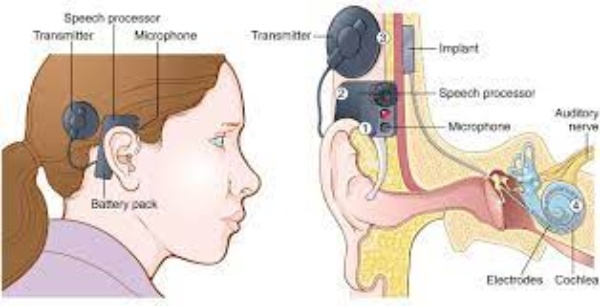For the most majority of people with hearing loss, hearing aids are the preferred method of communication. However, for those who are deaf or very hard of hearing, cochlear implants may be a more appropriate solution.
Individuals who have sensorineural hearing loss, which is defined as damage to the hair cells in the inner ear and/or the nerve pathways connecting the inner ear to the brain, benefit from both hearing aids and cochlear implants at a higher rate than others. It is the most common type of hearing loss in the United States, and it is caused by sensorineural hearing loss.
Hearing Aids Vs. Cochlear Implants: Which Is Better?
So, what exactly is the distinction between the two devices? Cochlear implants are surgically inserted into the ear canal by a trained surgical professional. People who are deaf or severely hard of hearing can benefit from these devices because they stimulate the auditory nerve and create the sensation of sound. Hearing aids are detachable devices that are used to increase sound for those who have some residual hearing in their ears. The user is responsible for inserting and removing them from the ear canal.
Read More: Best Antivirus With VPN In 2021
What Is A Hearing Aid And How Does It Work?
Hearing aids, as well as hearing aids for children, are small, electronic devices that are specifically intended to enhance sounds that are directed into the ear canal. The best-case scenario is when hearing healthcare specialists prescribe these devices after conducting a hearing evaluation. Hearing aids are most effective in youngsters and in those who have mild to moderate sensorineural hearing loss, according to research.
The modern digital hearing aid has at least one microphone, a computer processor that amplifies and processes sound, a speaker, and a battery, among other components. The enhanced sound is transmitted straight to the inner ear, where it is converted into electrical impulses, which are then transmitted to the brain by the auditory nerve.
Generally speaking, hearing aids can be divided into two categories: in-the-ear (ITE) models and behind-the-ear (BTE) models, each of which is available in a wide range of design options, including a variety of sizes, shapes, and colors. Hearing aid prices can range from $1,000 to as much as $4,000 per device, depending on the technology, features, size, and customizations. Because of the complex technology, hearing aid prices can range from $1,000 to as much as $4,000 per device. Insurance coverage is subject to change.
What Is A Cochlear Implant And How Does It Work?
Medical professionals must perform the surgical implantation of cochlear implants, which are complicated medical equipment that must be installed by a trained professional. These devices work by bypassing the injured region of the inner ear and stimulating the auditory nerve from the outside. In contrast to hearing aids, cochlear implants do not restore hearing; rather, they convey the sensation of sound to people who are deaf or have a severe hearing impairment.
Read More: Tips Of Valentines Day Emails
A Cochlear Implant Is Composed Of Two Major Components: The External Component And The Internal Component.
It contains a microphone, speech processor, and transmitter, all of which are located on the exterior component. A tiny wire connects the microphone and speech processor to the transmitter, which is located outside the ear over the receiver and is connected by a little connector.
The internal component consists of a receiver that is implanted under the skin just behind the ear, as well as one or more electrode arrays that are implanted deep within the inner ear. The receiver is implanted under the skin just behind the ear, and the electrode arrays are implanted deep within the inner ear.
The Two Major Components Are Connected By A Magnet.
A powerful magnet is used to connect the two components together. The sound collected by the microphone and speech processor is delivered to the receiver, which turns it into electrical pulses and sends them to the electrodes for processing. When the auditory nerve is stimulated by these electrodes, the brain receives a signal that allows it to process the sound.
Candidates undergoing cochlear implant surgery must first go through an audiological and psychological evaluation, as well as a medical checkup and imaging studies, before being considered. Because of the significant time commitment required following surgery, patients (or their parents) may benefit from counseling on the devices’ capabilities and limits. The implant is surgically implanted during a two- to four-hour surgery under general anesthesia, during which the patient is awake. The patient returns four to six weeks later, or as soon as the surgical site has healed, to be fitted with the external component, as well as to have their device activated and programmed.
Medically necessary cochlear implants are often covered by Medicare or Medicaid, with many private and commercial insurers also covering them. Patients may be responsible for considerable out-of-pocket payments or may be needed to obtain prior authorization for the surgical operation, depending on the insurer. As a result, many surgeons employ staff members who are specialized to assisting patients in determining the breadth of their coverage.
Read More: How To Make Digital Signature For Excel
Bone-Anchored Hearing Systems Are A Type Of Hearing Equipment That Is Attached To The Bone (Bahs)
Bone-anchored hearing systems are yet another alternative that can be utilized to treat a specific type of hearing loss. They operate best for persons who have at least one inner ear that functions properly, such as those who have conductive hearing loss or who have full hearing loss in one ear only, and who have at least one inner ear that does not function normally.
Bone-anchored hearing aids are made up of two parts: a titanium bone implant and an external sound processor that is connected to the implant. The external microphone and sound processor, once implanted and functional, translate sound into vibrations that are transmitted to the embedded implant. As a result, the implant causes the surrounding bone to vibrate, which causes sound waves to be transmitted to the inner ear.
The BAHS is implanted as an outpatient operation by a surgical specialist under general anesthesia. In a few weeks, the surgical site will be healed and the patient will return to have the external device connected and customized for their unique hearing loss.
Which One Is The Best Fit For You?
Hearing professionals are the only ones who can examine your hearing and determine whether or not you require a hearing device. If you notice that you aren’t hearing at your best, make an appointment to have your hearing assessed. If you have been diagnosed with hearing loss, consult with your hearing healthcare professional to determine the most appropriate hearing device for your hearing loss, lifestyle, and financial situation. Visit our database of hearing clinics, which includes reviews from real customers, if you are looking for a hearing care professional.
If you love reading this article, then you will more articles on my site, FarhanTech

